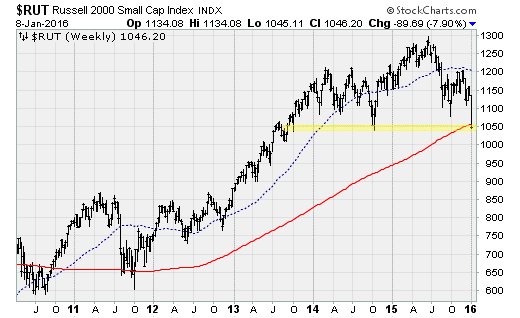Now, even the hottest stocks are getting cold
Asian trading started this week with another tumble, as China's Shanghai benchmark fell 5.3 percent on Monday. And while Europe is so far trading higher, the recent stock market sell-off clearly is getting serious: As of Friday, the Dow Jones industrial index is down 6.2 percent for the year to date, while the Russell 2000 small-cap index, which is on the verge of an outright bear market, is down 7.9 percent for the year and is 19.2 percent below its high set last summer.
Both the Russell 2000 and the NYSE Composite -- broader measures of stock market health than the Dow -- have fallen below their August-October lows. In fact, the Russell 2000 has dropped all the way back to levels last seen in October 2013 as it dropped below its 200-week moving average for the first time since 2011 as shown below.
Now, onetime momentum favorites that resisted the downside pressure such as Twitter (TWTR), Apple (AAPL), and Facebook (FB) are now being caught in the decline. TWTR lost the $20-a-share level on Friday for the first time ever. AAPL is below $100. FB is below $100. As a result, long-term measures of market health suggest investors should start considering whether the bull market we've enjoyed since 2009 is, in fact, under threat.
Many catalysts are in play. Chinese markets have been roiled by steep market losses, circuit-breaker trading halts, currency and credit market volatility, and weak economic data. That has spilled over into U.S. and European trading on contagion concerns.
Also, Friday's better-than-expected December U.S. payroll gain of 292,000 -- well ahead of the 200,000 consensus estimate -- supports the Federal Reserve's expectation of another four quarter-point rate hikes in 2016. Although this is about half the pace of a typical tightening cycle, it's twice as fast as the futures market is currently pricing in.
Fears of faster rate hikes are combining with the ongoing waterfall decline in crude oil, rising Mideast tensions, the approach of a sure-to-be-soft fourth-quarter earnings season and fresh weakness in the corporate bond market to spook stock prices lower.
Technically, stocks continue to look vulnerable as the CBOE Volatility Index (VIX) -- known as Wall Street's "fear gauge" -- rises to levels not seen since late September as investors pile into put option protection as insurance against further losses.
Unless the bulls can turn things around -- soon -- this will start looking like the onset of an outright bear market. One measure, the slope of the 12-month moving average on the S&P 500, was a solid predictor of the last two bear markets when it dipped into negative territory in late 2000 and early 2008. That measure has been in negative territory since September.
Admittedly, there was a false alarm in 2011 amid the fallout from the U.S. credit rating downgrade.
But fresh hurdles will soon appear with the start of the fourth-quarter earnings season on Monday when Alcoa (AA) reports because it's set to be the third consecutive quarter of negative earnings growth for the S&P 500. That's a run of falling profitability not seen since the financial crisis.
And we've got another Fed policy meeting on Jan. 26-27 that will bring a likely rate hike at the March 15-16 meeting into focus. That's especially so because December's job gains capped the second-best year for job creation since 1999. However, wage inflation is relatively stable, with average hourly earnings up 2.5 percent vs. last year in December.
One thing is for sure: So far, the New Year sure doesn't lack excitement.

